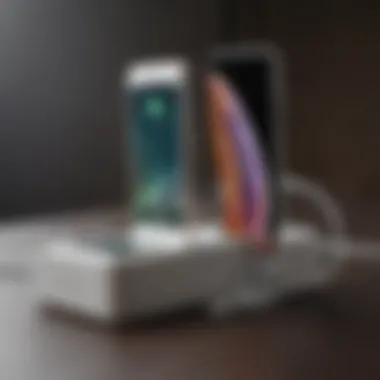Understanding Apple Quick Chargers: A Comprehensive Review


Intro
In today’s digital age, fast charging has become a crucial feature for smartphone users. Apple quick chargers play a significant role in enhancing the user experience for Apple products. Understanding how these chargers work, their advantages, and proper usage can help users make informed decisions.
The complexities of charging technology may be overlooked, yet they are vital for maintaining device efficiency. Quick chargers are designed to provide higher wattage output, enabling devices to recharge at a faster pace. This article aims to provide insight into several critical areas regarding Apple quick chargers, including their performance, safety features, and comparisons with other solutions on the market.
Prolusion to Apple Quick Chargers
In today's fast-paced environment, efficient charging solutions have become essential. Apple quick chargers represent a significant advancement in charging technology, providing notable benefits for users of Apple devices. Understanding this topic helps consumers maximize the potential of their gadgets while ensuring device health and longevity.
Apple quick chargers are designed to reduce charging time significantly. This straightforward benefit addresses a common frustration among users: long waiting periods for devices to power up. A quick charging solution enables users to spend less time tethered to a wall socket. It is particularly advantageous for individuals constantly on the go, allowing for brief charging sessions between activities.
Another essential consideration is the compatibility of Apple quick chargers with various devices within Apple's ecosystem. From iPhones to iPads and MacBooks, quick chargers facilitate efficient energy transfer across a range of products. This compatibility assures users that they can rely on one charger for multiple devices, simplifying their accessory needs.
Additionally, safety cannot be overlooked. Apple prioritizes safe charging practices, embedding multiple protective features within their quick chargers. This focus on safety helps prevent overheating and potential damage to devices, which is crucial for maintaining battery health in the long term.
Apple quick chargers also come with an impressive power output, which directly correlates to charging speed. Understanding this power output enlightens users about getting the most from their devices, especially when it comes to performances during high usage scenarios.
The Evolution of Charging Technology
The development of charging technology has greatly influenced how we interact with our devices today. Over time, there has been a progression not just in speed but also in efficiency and safety. This evolution ensures that consumers make the most of their devices without unnecessary complications. Understanding this history provides context for the current offerings from Apple and how they meet the modern needs of users.
Historical Perspective
In the early days of mobile devices, charging was a slower and less efficient process. Devices like the early cell phones and basic mobile units utilized basic transformer-style chargers. They typically took hours to reach a full charge and lacked any intelligent systems to optimize performance. The charging cables were often bulky and less user-friendly.
As technology progressed through the years, manufacturers began to innovate. The introduction of lithium-ion batteries marked a significant turning point. These batteries not only had a higher energy density but also charged more efficiently. As a result, devices could now utilize smaller, compact chargers that delivered power with greater speed and efficiency. Companies began to focus on charging time as a key feature, directly affecting the user experience. The demand for faster charging became an important driver for new technology and features.
Transition to Rapid Charging
The movement toward rapid charging techniques gained momentum in the 2010s as consumers desired quicker solutions for their devices. The introduction of features such as Qualcomm’s Quick Charge and USB Power Delivery highlighted how manufacturers could deliver higher wattages safely. Rapid charging technology allows devices to charge at significantly increased rates without burning out the battery.
Apple recognized this trend and adapted its approach with the release of quick chargers compatible with its devices. Power adapters like the 20W USB-C charger emerged, allowing users to quickly charge their iPhones and iPads. This shift not only improved user satisfaction but also aligned with the ongoing trend of multitasking and efficiency favored by today’s consumer.
Rapid charging technology has transformed expectations surrounding device usability, making it essential in today’s fast-paced environment.
Through these developments, Apple has ensured compatibility and performance across its ecosystem, leveraging advancements in charging technology to provide optimal experiences. The evolution of charging technology reflects a deeper engagement with user needs; as devices become more powerful, the means of charging must adapt accordingly.
What is Quick Charging?
Quick charging is not just a convenience; it represents a significant leap in charging technology that underpins the efficiency of modern devices. Understanding quick charging is essential for Apple users who wish to maximize their device's performance and lifespan. The need for rapid power replenishment is increasing, particularly in today's fast-paced environment. This section will discuss the definition of quick charging, its mechanisms, and the various types of quick chargers available in the market.
Definition and Mechanism
Quick charging refers to a technology that allows devices to charge significantly faster than traditional methods. In simple terms, it increases the amount of electrical current delivered to a device's battery. The mechanics of quick charging rely on two critical components: the charger itself and the device being charged.
Most quick charging solutions utilize a higher voltage when charging, allowing for more energy transfer within a short period. For instance, Apple's quick chargers work optimally with their devices by using a specified wattage to facilitate faster charging sessions. This technology takes advantage of the USB Power Delivery standard, which ensures that devices communicate their current needs with the power source. This back-and-forth helps prevent excessive heat generation while maximizing charging speed.


In practice, this means that an Apple device capable of fast charging, such as the iPhone 8 or newer, can charge up to 50% in approximately 30 minutes when connected to a compatible quick charger. Thus, knowing how this technology works can greatly enhance user experience, keeping devices powered longer without lengthy wait times.
Types of Quick Chargers
There are various types of quick chargers available in the market today. Understanding these types can help Apple users make informed choices about their charging solutions.
- Apple Adaptive Chargers: These chargers adjust their output according to the device's specifications, ensuring optimal charging. The Apple 20W USB-C power adapter is a popular model known for compatibility across various devices.
- Third-Party Quick Chargers: Brands like Anker and Aukey also provide quick charging solutions. These may offer different functionalities, such as multiple charging ports or added protection features. However, it is crucial to choose reputable brands to avoid compatibility and safety issues.
- Wireless Quick Chargers: These chargers enable cable-free charging via Qi technology. While they offer convenience, they may not reach the fast speeds of wired chargers. Still, models like the Apple MagSafe charger have elevated the performance of wireless solutions considerably.
- Automotive Quick Chargers: For users on the go, some car chargers support quick charging. These devices ensure that you can get a rapid battery boost while driving, which is crucial for today’s active lifestyle.
In summary, knowing the different types of quick chargers available can help every user determine what best suits their needs. Each type presents unique features and advantages, catering to various scenarios and preferences.*
Key Features of Apple Quick Chargers
Apple quick chargers are designed to enhance the charging experience for Apple device users. The importance of understanding their key features lies in optimizing device usage and ensuring longevity. These features include charging speed, safety mechanisms, and compatibility with various Apple products. Each aspect plays a significant role in the overall effectiveness and reliability of quick charging.
Charging Speed
Charging speed is a crucial element that distinguishes Apple quick chargers from standard ones. Apple’s quick chargers utilize higher wattage power output, which translates to faster charging times. For example, moving from a 5W charger to an 20W charger can significantly reduce the time taken to fully charge an iPhone or iPad. This becomes essential for users who are dependent on their devices throughout the day and cannot afford extended charging times.
When it comes to charging speed, the technology employed by Apple is designed to maximize efficiency while minimizing battery strain. The ability to charge an iPhone up to 50% in approximately 30 minutes is a notable benefit, emphasizing the user convenience. This is particularly beneficial in urgent situations where quick recharging is necessary.
Safety Mechanisms
Safety is paramount in the discussion of quick chargers. Apple integrates several safety features into its chargers to mitigate risks associated with rapid charging. These mechanisms involve thermal management, overcurrent protection, and intelligent software management that monitor charging cycles. This ensures that devices do not overheat during the charging process.
The built-in safety protocols are especially essential for maintaining battery health over time. Apple quick chargers continuously adjust the power output based on the device's needs, preventing potential damage. As a result, users can charge their devices confidently, knowing that the technology in place prioritizes safety without compromising on performance.
"Safety in charging is not just a feature; it is an essential necessity for device longevity."
Compatibility with Apple Products
Compatibility is another vital aspect of Apple quick chargers. These chargers are specifically designed to work seamlessly with a range of Apple devices, ensuring that users get the best possible charging experience. From iPhones and iPads to Macs, Apple's quick charger technology encompasses the entire ecosystem.
This compatibility extends beyond just physical connections. Quick chargers automatically detect the device they are connected to and adjust accordingly. This feature is essential for users who own multiple Apple devices, as it eliminates the hassle of having numerous chargers. Understanding compatibility helps users make informed decisions, ensuring they select the right charger for each device.
Benefits of Using Apple Quick Chargers
Apple quick chargers bring several advantages that cater specifically to the needs of Apple device users. As charging technology evolves, the relevance of having a reliable and efficient charger continues to grow. Quick charging can significantly impact daily device use, optimizing both time and performance. Let us examine the vital benefits of utilizing Apple quick chargers.
Time Efficiency
With today's fast-paced lifestyle, time management is vital. Apple quick chargers enhance time efficiency remarkably. For instance, a typical charger may take several hours to charge your iPhone, but an Apple quick charger can achieve a full charge in a fraction of the time.
Rapid charging reduces downtime for devices, which is critical when users rely heavily on their smartphones, tablets, or laptops. This feature not only improves convenience but also aligns with a user's productivity requirements.
Consider this:
- iPhone charging: Some models can reach up to 50% battery in approximately 30 minutes with the right quick charger.
- iPads and MacBooks: These devices benefit similarly, saving users significant waiting time.
"In a world where every second counts, every minute saved charging translates into productivity gains."
In extreme cases, this can mean the difference between forgetting to charge a device overnight and having a fully charged battery ready to go in under an hour.


Enhancing Device Longevity
One of the crucial concerns for any tech enthusiast is device longevity. Quick chargers, particularly those designed by Apple, incorporate various safety features that help protect devices from damage. They maintain an optimal charging speed to avoid overheating, which can degrade a battery's performance over time.
By using the correct quick charger:
- Batteries can maintain a healthier cycle: This helps prolong overall battery life, as devices run on optimal battery conditions during use.
- Reduced risk of wear: Over time, consistently charging with standard speeds can affect battery health. Quick chargers mitigate this risk by managing power distribution effectively.
Furthermore, Apple’s commitment to safety extends to their quick chargers, ensuring that they are compatible with specific models, reducing the risk of damage caused by mismatched power levels. This leads to a longer lifespan for devices and less frequent replacements or repairs, thus serving both the environment and the wallet well.
In summary, using Apple quick chargers is not just about convenience. It brings several benefits, including improved time efficiency and enhanced longevity of devices. Understanding these advantages allows users to make informed decisions about their charging needs, ensuring they get the most out of their Apple products.
How to Choose the Right Quick Charger
Choosing the right quick charger is essential for optimizing the performance of your Apple devices. With various models on the market, understanding specific aspects can greatly enhance your charging experience. Factors such as wattage, compatibility, and features often dictate the efficacy of a charger. A well-informed decision ensures that you get the best charging speed and safety for your devices. Here, we will delve into the critical elements that influence the selection of the right charger.
Understanding Wattage Needs
Wattage is a key consideration when selecting a quick charger. Different devices have varying power requirements. For instance, the iPhone 12 can handle up to 20 watts for fast charging, whereas the iPad Pro may require up to 30 watts or more. Knowing the appropriate wattage is crucial. Using a charger with lower wattage may lead to slower charging speeds, while a higher wattage charger can often charge compatible devices more quickly.
- Device Model: Identify the wattage your specific device supports. This information can usually be found on the specifications sheet or the Apple website.
- Charger Branding: Apple chargers generally offer optimal wattage for their products. However, third-party brands may have varying levels of compatibility.
Identifying Compatible Models
Not every quick charger is suitable for every Apple device. It’s important to ensure compatibility to avoid any issues. Apple products usually outline compatible chargers in their user manuals. Two considerations include:
- USB-C Compatibility: Apple’s recent devices, like the iPhone 12 and later, utilize USB-C for fast charging. Check that the quick charger supports USB-C.
- Charger Type: Ensure that you are using a charger designed for your device type, be it iPhone, iPad, or MacBook.
"Using a charger that is not compatible can lead to inefficient charging and potentially damage your device."
Additionally, consider whether a particular charger supports functionalities such as Power Delivery (PD), which allows for faster and efficient charging. In summary, understanding these elements will equip you to make an informed choice, ensuring that your devices charge efficiently and safely.
Comparative Analysis: Apple vs. Other Brands
In the landscape of consumer technology, charging solutions are critical to device performance and user experience. Apple Quick Chargers offer specific advantages, but understanding their position in relation to other brands is essential for making informed choices. This analysis is crucial as it explores not only the functionality of Apple chargers but also the varied technology strategies adopted by competitors. It guides potential buyers through evaluating their options, considering factors such as safety, charging speed, and device compatibility.
Brand Specific Technologies
Different brands employ unique technologies in their charging solutions, which can significantly affect performance. Apple utilizes its proprietary fast charging technology, which is compatible with devices such as the iPhone, iPad, and MacBook. The chargers adhere to the USB Power Delivery (USB PD) standard, allowing for higher wattage outputs without compromising device safety. This technology adjusts the voltage and amperage for optimal charging speed according to the device's needs.
In contrast, brands like Samsung and OnePlus also offer rapid charging through their own specific protocols. For instance, Samsung employs Adaptive Fast Charging which can achieve high speeds similar to those found in Apple’s offerings but may not always ensure the same level of device protection. OnePlus features Warp Charge, allowing their devices to reach significant battery percentage in a short span. These different technologies can lead to notably different user experiences, making it vital to understand each brand's strengths.
Pricing Considerations
When analyzing quick chargers, price is a significant factor and can vary widely across brands. Apple's chargers tend to be priced at a premium, reflecting the investment in development, brand heritage, and quality assurance. However, dem>iscounts and bundles with purchases can offset some cost concerns.em>
On the other hand, brands such as Anker or Aukey may offer competitive chargers at lower price points. These alternatives often boast high compatibility with various devices, providing cost-efficient options for consumers. Yet, it is essential to examine quality and reliability, as non-branded or cheaper options could compromise safety measures or charging speeds. Understanding these pricing landscapes helps consumers align their budget with expectations for performance and safety.


Best Practices for Quick Charging
Understanding the best practices for quick charging is essential for anyone using Apple devices. These practices not only improve charging speed but also contribute to the device's longevity and safety. By recognizing the practical steps involved in quick charging, users can significantly enhance their overall experience with Apple products while reducing the risk of damage.
Avoiding Overheating
Overheating can be a serious risk when it comes to quick charging. It is vital to monitor the temperature of the device during the charging process. Excessive heat can lead to several problems, including reduced battery life and potential damage to internal components. To mitigate overheating, consider the following recommendations:
- Charge in a cool environment: Ensure that the device is in a space where airflow is sufficient. Charging on soft surfaces, such as beds or couches, can trap heat.
- Remove cases during charging: Some cases can insulate the device, preventing heat dissipation. Removing these cases during quick charging can help keep the temperature in check.
- Avoid using the device while charging: Engaging in extensive processes, such as gaming or video streaming, can increase heat output. It is better to let the device charge undisturbed for optimal results.
Implementing these practices will not only enhance the efficiency of quick charging but also protect the battery and hardware of the device, ensuring a long-term healthy performance.
Utilizing Original Cables
Using original charging cables is another critical aspect of best practices for quick charging. Apple's designs ensure optimal compatibility and safety through these cables. However, many users might be tempted to opt for third-party cables due to cost-effectiveness or convenience. Such choices may come with risks. Here are key considerations for using original cables:
- Guaranteed compatibility: Original cables are engineered to work specifically with Apple devices, ensuring that the correct amount of power flows to the device.
- Safety features: Apple cables often include built-in mechanisms to prevent overheating and power surges, reducing the chances of damage during the charging process.
- Performance optimization: These cables are designed for fast charging, allowing users to maximize charging speeds without sacrificing safety.
Future of Charging Technology
The future of charging technology stands as a critical component of the ongoing evolution in consumer electronics. As devices become more advanced, the demand for faster and more efficient charging solutions grows increasingly urgent. This section will explore significant trends and potential innovations that shape the upcoming landscape for quick charging, especially within the Apple ecosystem.
Emerging Trends
The rise of wireless charging is one notable trend that is gaining traction. Consumers increasingly prefer the convenience of not dealing with cables. Brands, including Apple, are enhancing their wireless charging capabilities to be as efficient as wired counterparts. Moreover, innovations in alignment technology allow more precise power transfer, reducing energy loss. Additionally, the shift towards proprietary protocols, like Apple's MagSafe, facilitates optimized communication between devices and chargers. These developments not only improve the user experience but also enhance device safety and efficiency.
Another trend is multi-device charging. Modern households increasingly own various gadgets, from smartphones to wearables. Chargers designed to accommodate multiple devices simultaneously are becoming popular. Apple's latest power adapters aim to support charging configurations for multiple devices without compromising speed or safety.
The integration of artificial intelligence in charging systems signifies a cutting-edge advancement. AI can analyze device usage patterns and adjust charging speeds accordingly, ensuring optimal power delivery while preserving battery health over time. Smart chargers that adapt to user behavior can extend battery life, making this a vital aspect of future charging technology.
Potential Innovations by Apple
Apple is renowned for pushing boundaries in technology, and charging devices are no exception. Future innovations may include enhanced fast charging capabilities beyond what is currently available. By developing higher wattage adapters and optimizing internal circuitry, Apple may reduce charging times significantly for devices like iPhones and iPads.
Another potential direction is universal compatibility. As the tech landscape diversifies, the need for a unified charging solution becomes evident. Apple might explore a model that allows its chargers to work effectively across various brands and devices, easing the frustrating burden of incompatible cables and adapters.
Sustainability will likely play a pivotal role in Apple’s future charging technology. As environmental concerns gain prominence, Apple might invest in eco-friendly materials and renewable energy sources for their manufacturing processes. Future chargers could also implement energy-efficient designs that minimize power waste, aligning with the company's commitment to reduce its carbon footprint.
"The future of charging technology is not merely about speed; it emphasizes efficiency, convenience, and sustainability."
In summary, the future of charging technology is a dynamic topic. The drive for innovations from Apple and emerging trends will shape how consumers interact with their devices. Understanding these developments is crucial for tech enthusiasts and industry professionals alike, ensuring they remain informed and prepared for the evolving landscape of charging solutions.
Ending
In summary, this article has reviewed the significance of Apple Quick Chargers in enhancing the user experience within the Apple product ecosystem. The importance of quick charging cannot be overstated; it successfully balances the need for speed and device care. Users can appreciate faster, more efficient charging while also extending the longevity of their devices.
Key considerations outlined include the compatibility of chargers with various Apple models. Understanding these aspects leads to informed purchasing decisions, allowing users to maximize their investment in Apple products. Additionally, recognizing the safety mechanisms built into Apple Chargers mitigates concerns regarding overheating, thus ensuring a risk-averse charging environment.
Noteworthy benefits introduced in previous sections include the time efficiency provided by quick chargers. These devices save precious moments in busy schedules, transforming how users integrate technology into their daily lives. Moreover, using the appropriate charging solution enhances device performance over time, which is an often overlooked aspect that users will appreciate.
Quick charging technology is continuously evolving, and thus this conclusion should serve as an invitation to keep informed about future developments. As manufacturers push boundaries for optimal efficiency, users must adapt quickly to these innovations. Staying engaged with trends laid out in this article keeps one at the forefront of charging technology.
"The adaptability and integration of quick chargers signify a leap forward not just in technology, but in user lifestyle and convenience."
In closing, as Apple aficionados or tech enthusiasts navigate the landscape of device charging, understanding the nuances of Apple Quick Chargers will empower them to make thoughtful, knowledgeable decisions. Being informed about the options available enhances the overall experience with Apple's array of devices, ultimately benefiting user satisfaction in the long run.



